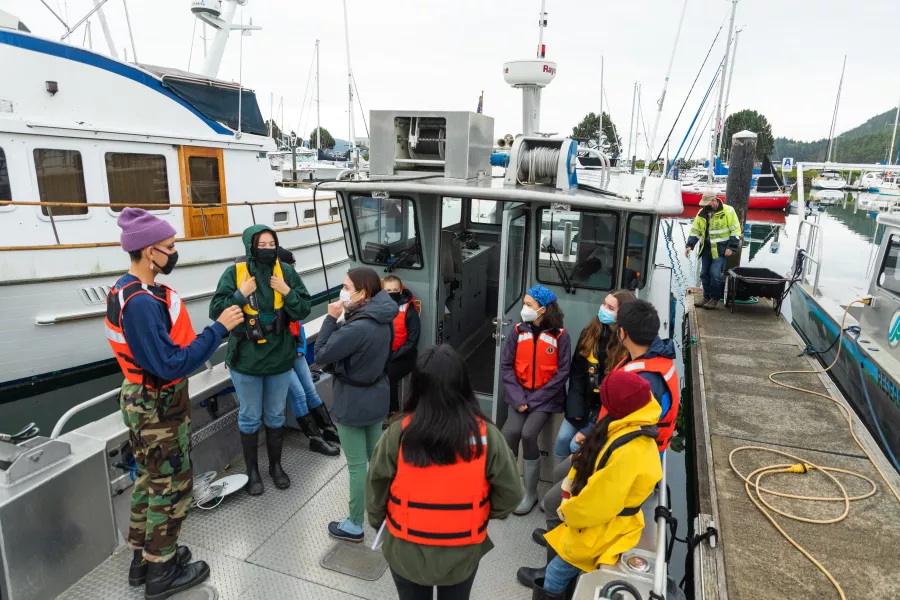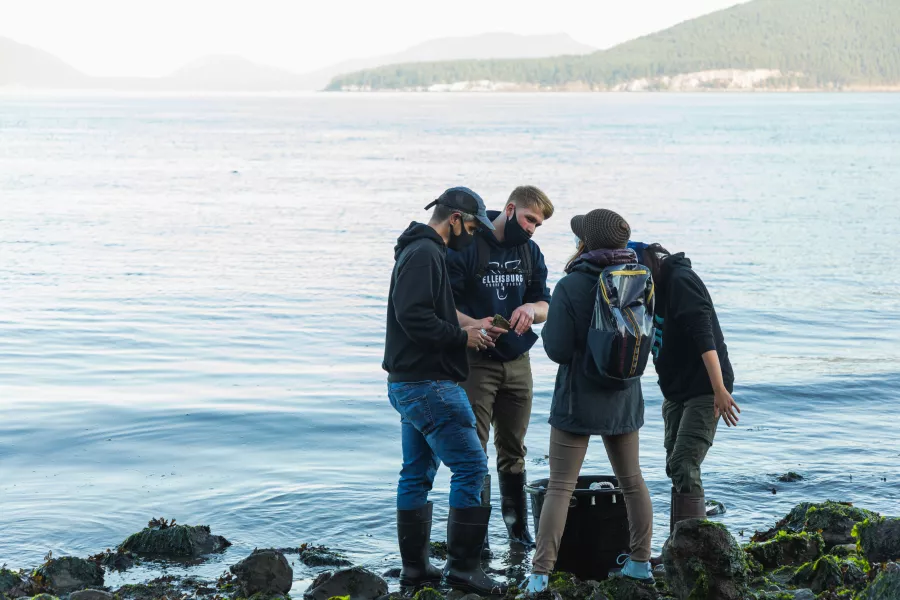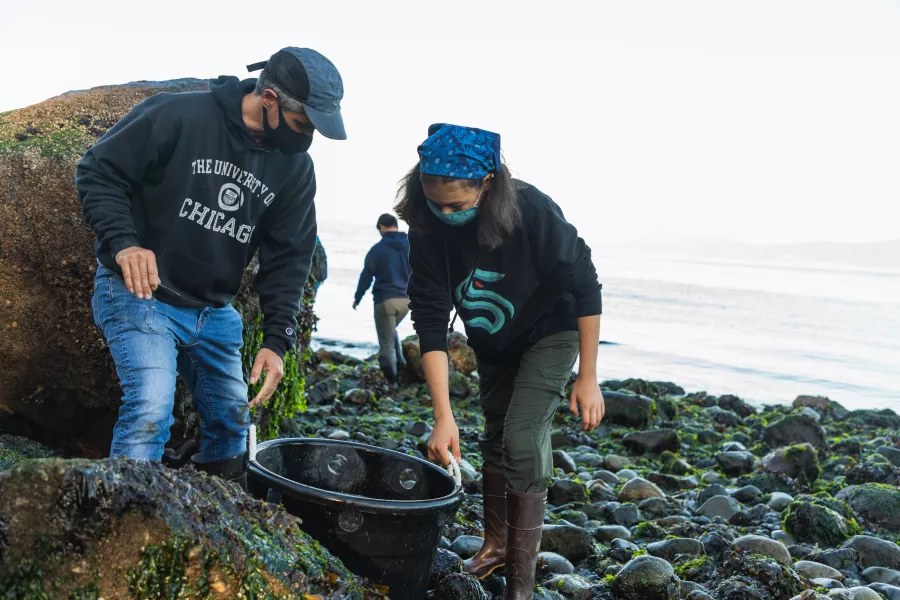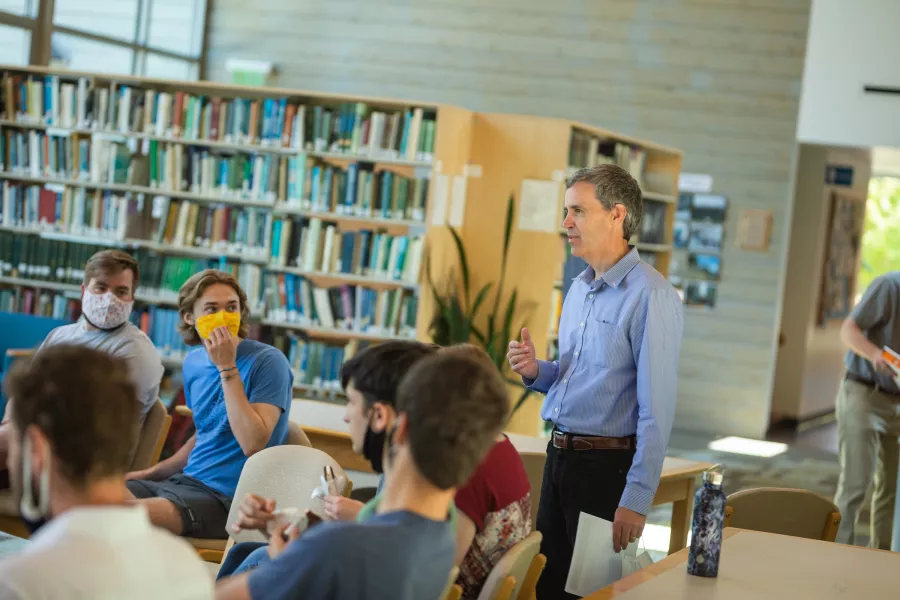Perhaps the most surprising thing about the new Marine and Coastal Sciences Program at Western is that it didn’t already exist.
For close to 50 years Western faculty have worked side-by-side with graduate and undergraduate students at the Shannon Point Marine Center outside Anacortes, motoring out in research vessels to collect samples and conduct tests in a deep-water habitat, diving through murky water to study marine life, and growing and analyzing plants and animals in high-tech labs. Every fall since 2012, a group of budding marine scientists start their Western experience by living and researching at Shannon Point as part of the Marine Science Distinguished Scholars program.
But until now, if those students decided to continue in marine science, they had a choice to make: They could major in biology and focus on marine biology, become environmental science majors with a marine science emphasis, or major in geology or chemistry and emphasize marine-focused research.
That’s all about to change with the introduction of the Marine and Coastal Sciences major, according to Brooke Love, an associate professor in environmental science who worked with an interdisciplinary team to develop the program and establish the curriculum.
Love, the MACS academic program director, says having a dedicated marine science major offers students the chance to combine classes from four departments—Biology, Environmental Science, Geology and Chemistry—plus the opportunity to live and work at Shannon Point.
“We have the expertise, we have a lot of classes and we have these emphases, but it’s not the same as having a major that builds between the different departments,” Love says. “I wouldn’t say it’s better, I’d say it’s more.”
MACS Director Brian Bingham, who has worked at Shannon Point for more than 30 years, says the new program makes it easier for faculty members to collaborate on research, develop new courses and work together. The eight professors teaching in the MACS program all have split appointments, half in marine and coastal sciences and half in their home departments.
“We have a lot of outstanding marine scientists, but they’re scattered around multiple departments,” Bingham says. “So, it brings in the interdisciplinary aspect at a much higher level than would have been possible before.”
In addition to the interdisciplinary focus, the MACS program is founded on a belief in immersive, experiential learning and the power of student cohorts to build a supportive community.
A would-be dentist reconsiders
Bingham experienced the transformative power of such a learning environment firsthand when, as an undergraduate at Brigham Young University, he took part in a six-week program at University of Washington’s marine laboratory in Friday Harbor. At the time, he was training to become a dentist.
“That was the experience that got me into this career and helped me, in so many ways, really get excited about it, realize I could do this and that I wanted to do this,” he says.
Bingham returned to the Northwest in 1990 to develop a diversity outreach program at Shannon Point. At the time, the marine center consisted of a single lab building, constructed in 1974. The living quarters were converted trailers that had served as Army officer barracks, where the sole means of communication was a solitary pay phone outside the trailers beneath the towering trees.
“It was pretty rustic,” Bingham says.
Eventually, the program, the Multicultural Initiative in the Marine Sciences: Undergraduate Participation or MIMSUP, won 25 years of continuous grant funding from the National Science Foundation and special recognition from the White House. It also launched the careers of dozens of marine scientists, including Associate Professor Shawn Arellano.
Years later, Arellano worked with Love on the committee to develop the Marine and Coastal Sciences program and became part of the MACS faculty.
In the same way Bingham’s experience at Friday Harbor shifted his plans, participating in the MIMSUP program as an undergrad from the University of Kansas made Arellano realize it was possible to pursue a career as a marine scientist. Like Bingham, Arellano attended college far from the ocean. Before her exposure to marine studies, she planned to become a pharmacist. The six-week Multicultural Initiative in the Marine Sciences program opened her eyes to a new world under the water’s surface and along its shores.
“I learned about the biology of invertebrates for the first time, and embryological development. I learned about the intertidal and invertebrates, oceanography and the deep ocean,” Arellano says. “It was a transformational experience.”
Arellano’s life came full circle in 2012, when, after earning a doctorate in marine biology at the University of Oregon, she returned to Western to work with Sylvia Yang, now research coordinator of the Padilla Bay National Estuarine Research Reserve, to develop the Marine Science Distinguished Scholars program. The immersive residential learning experience at Shannon Point for incoming freshmen is similar to the program that 12 years earlier changed her life.
As part of the Marine Science Distinguished Scholars program, 21 students live at the marine center, go out on research vessels, study marine ecosystems and conduct research in the Shannon Point labs. Throughout their first two years at Western, that same cohort of students takes fieldtrips together and participates in marine science seminars.
The new MACS program incorporates aspects of the MIMSUP and the Marine Science Distinguished Scholars programs into a major that emphasizes immersive research, establishes cohorts and includes a residential component.
‘There's so much to discover’
Among the first MACS cohort is Lucy Greeley, a 20-year-old junior, who discovered her love for marine science in high school and volunteered at the Seattle Aquarium, where her favorite thing to do was to tell visitors about the massive six-gill sharks that thrive deep in Puget Sound. She went from explaining sea life to aquarium visitors to earning her scuba certification and exploring the depths herself.
“Puget Sound has a lot of biodiversity, but they’re all camouflaged or hiding and you’re going along and you see something poke out,” she says. “It’s magical.”
Scuba diving and volunteering at the aquarium awoke a desire in Greeley to introduce the public, especially young people, to the wonders of the ocean.
“One of the exciting things about marine science is there’s so much unknown,” she says. “There’s so much to discover.” Greeley says she is most excited to spend time at Shannon Point. Students accepted into the MACS major either take part in the scholars program as freshmen or complete a similar one-week residency at the end of their sophomore year.
Bingham says the major’s progression should allow for individual student interest while building a strong bond with their cohort and exposing students to the rigors and joys of being marine scientists.
“They’re engaging in research here. They’re meeting with faculty here. There’s a residential aspect,” Bingham says. “So, it really is a very different experience for a student rather than a traditional track through a degree program in a single department.”
In many ways, Gabi Vitale’s path to the MACS major parallels that of Bingham and Arellano. She grew up in Michigan, far from the ocean shore. She discovered her love of marine animals through the only outlet available to her, a local pet store between her home and the restaurant where she worked as a hostess.
“I would stop there all dressed up and just decompress in this little fish store,” she explains.
After a few weeks, Vitale got to know the store’s owner and he hired her.
“My favorite animals changed from these big, charismatic species to these little shrimps, corals, starfish,” Vitale says. “I loved getting out the starfish and having the kids hold them and telling them about it.”
The power of belonging
Although Vitale and Greeley are not first-generation college students, many of their peers in the MACS program are. Among the first cohort of 27 students, former Program Manager Debbie Arthur says more than a quarter are students of color and a similar percentage are the first in their immediate families to attend college. In terms of the incoming Marine Science Distinguished Scholars, which will become a feeder program for the MACS major, Arthur says almost half are students of color and 57 percent are first-generation college students.
Having a cohort of students with similar interests and goals helps students who may not feel comfortable in the university setting, according to Love, who taught and mentored minority students for years as a faculty member in the MIMSUP program.
“Being in a cohort can be really powerful for helping every student develop an identity as a marine scientist and have the support they need to succeed in college,” she says. Although she has yet to meet her fellow MACS majors in person, Vitale says she has a strong feeling about the program, the faculty and the other students in the program so far.
“It feels like we get to be a part of building this program and then also pass that on to the next cohort that goes through,” she says. “It’s this living thing that will keep growing and changing.”
That excitement carries over to faculty and staff. Love, the academic director, says she and her colleagues have the luxury with the MACS program of starting with goals and developing a program specifically tailored to meet those goals. “Most programs have been going for 30 years and it’s more like, ‘OK, here’s what we’ve got, how can we tweak it?’” she says. “We’re building something new.”
Bingham says the MACS program reflects many of Gov. Jay Inslee’s goals for restoring and protecting natural resources and increasing student training in STEM fields. The urgency of the climate crisis and its ongoing impact on ocean life and the marine ecosystem has created the need for a new generation of adept and equipped marine scientists, Bingham says.
“You can’t look at our oceans and not realize we have an urgent need for better-prepared scientists, people who can talk across disciplines and understand and work across disciplines in ways that will address the accelerating rate of change of our oceans and the impacts that cascade through the entire system we live in,” he says.
Bingham and Arellano have helped shape the MACS program to reflect the transformative experiences they had as undergrads exposed to immersive experiential fieldwork. In a similar sense, MACS students Greeley and Vitale hope to pass on their passion and concern for the marine ecosystem.
“Just wanting people who come after me to see the same creatures and experience the same ocean I have,” Vitale says. “It’s really important to do what we can and convince other people to care.”



